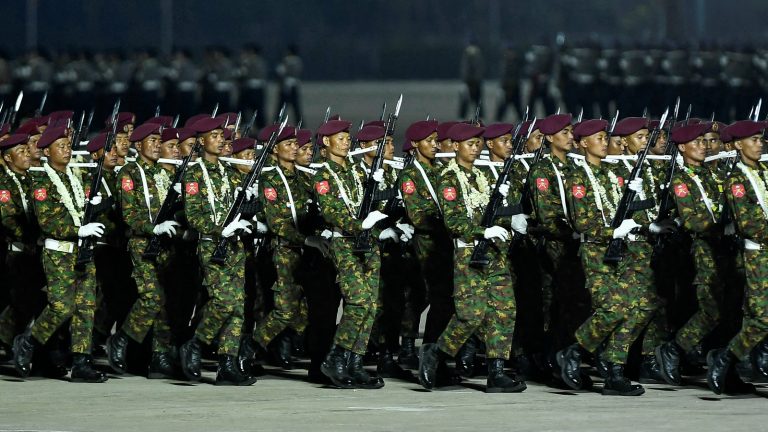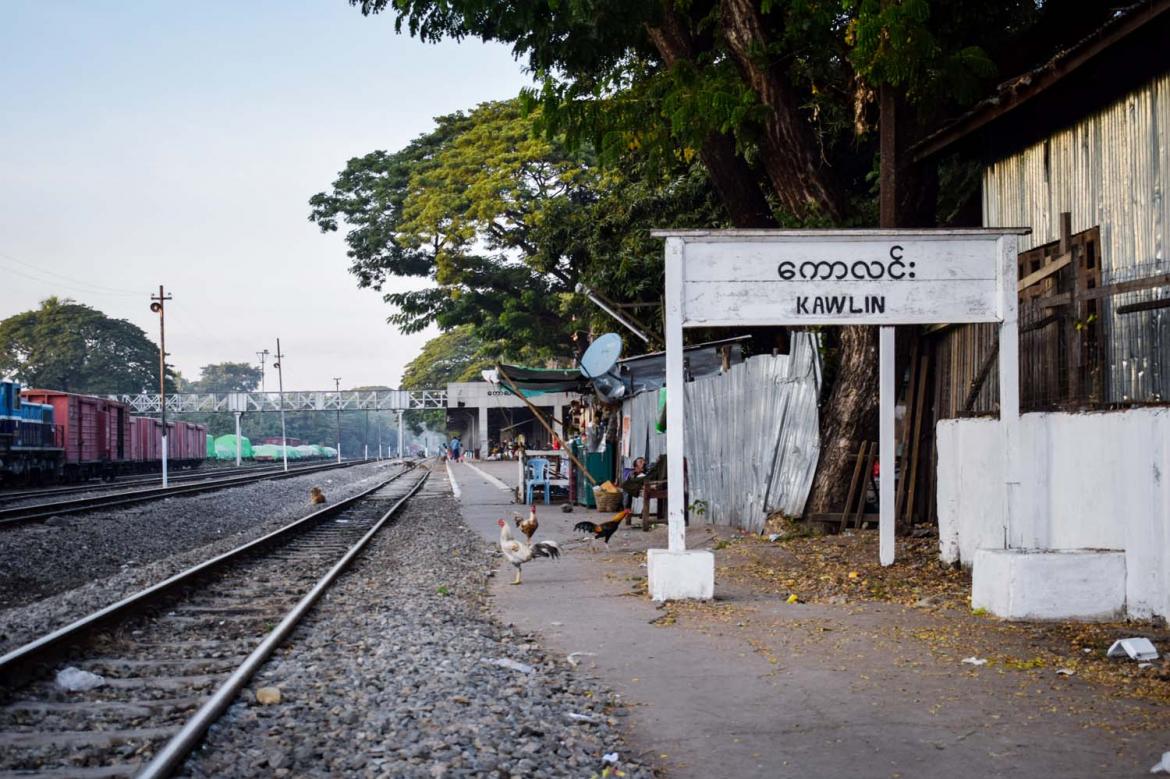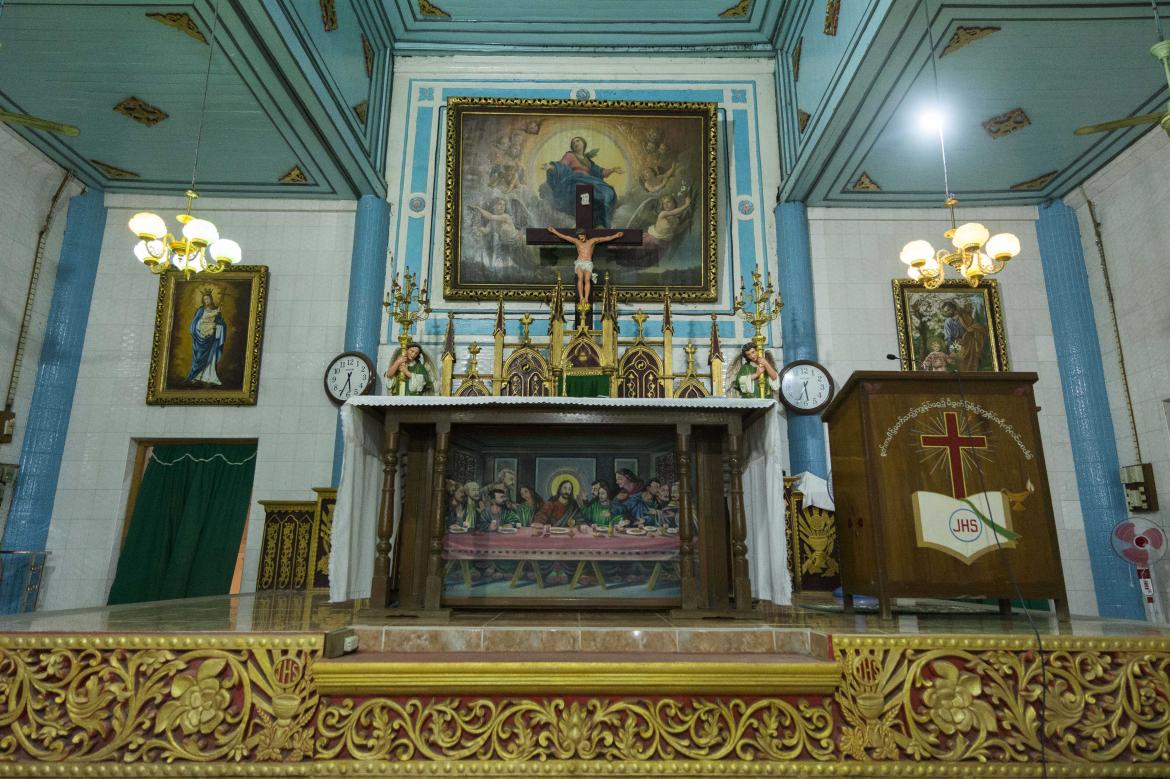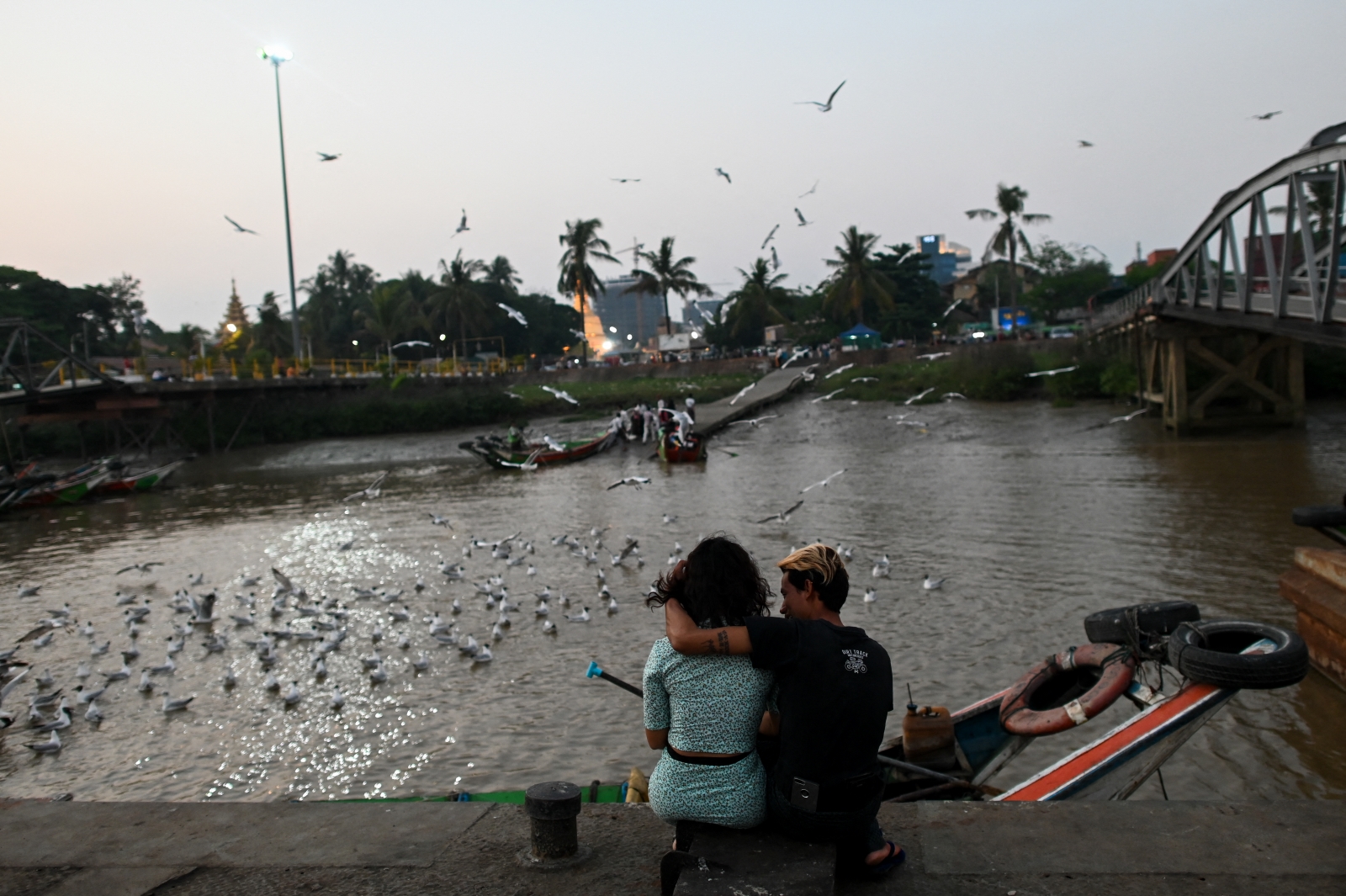The resistance has seized a series of towns in recent months, marking a clear escalation in the war to overthrow the military regime, but questions remain about the viability of the strategy.
By FRONTIER
Ko Myo*, a fighter in the Kawlin People’s Defence Force, was full of pride when his unit seized Kawlin town in Sagaing Region and hoisted the flag of the National Unity Government, a parallel administration appointed by lawmakers ousted in the 2021 military coup.
But his joy was tinged with anxiety.
“I’m happy we were able to capture the town, but I also worry about how we will maintain it. When we capture a town like that, the thought that’s always in my head is whether the military will surround it and attack,” he told Frontier.
Since the coup, armed groups opposed to military rule have surprised observers with a string of battlefield victories, carving out significant territories in rural areas and the borderlands. But one achievement continued to prove elusive – seizing control of major towns.
Often relying on roadside ambushes and attacks using improvised explosive devices, resistance armies were able to inflict lopsided casualties on the enemy. But given the military’s superior firepower and disregard for civilian life, seizing towns was both difficult and inevitably resulted in death and destruction.
In February this year, PDFs briefly seized control of Shwe Pyi Aye town in Sagaing’s Homalin Township before retreating in the face of air strikes. Even veteran armed groups have struggled in this regard, with the Karen National Union reportedly trying and failing to seize Kyondoe and Kawkareik towns in Kayin State in October last year.
Dr Sasa, the NUG’s international cooperation minister, invited ridicule last year when he suggested that resistance groups should simply seize control of cities with airports. But after a series of stunning resistance gains in recent months, his comments no longer seem so absurd.
Myanmar’s battlefield landscape changed dramatically when the Three Brotherhood Alliance of ethnic armed groups launched a major offensive in late October, known as Operation 1027, quickly overrunning the military across northern Shan State.
The offensive was spearheaded by the Myanmar National Democratic Alliance Army, which has since seized control of a handful of towns, including Mong Ko and Chin Shwe Haw, important trade hubs on the Chinese border. But the fighting hasn’t been confined to northern Shan. Another Brotherhood member, the Arakan Army, is contesting Pauktaw town in Rakhine State; the Karenni Nationalities Defence Force has launched an assault on the Kayah State capital Loikaw; Chin resistance groups claimed control of a few towns near the border with India; and PDFs in Sagaing are making their moves.
In some cases, resistance gains have been exaggerated or quickly reversed by the military. Some outlets reported in late November that the Sagaing town of Taze had fallen, but later reports indicated resistance groups managed to raid some regime positions before falling back in the face of airstrikes and artillery. The KNU claimed control over Mone town in Bago Region in early December, but within days the military was sharing photographs of its troops back in the town.
This shows the war isn’t just being fought on the battlefield, but also in cyberspace. The fall of these towns has been a tremendous boost to resistance morale – particularly important for an armed struggle that is largely crowdfunded. But while some elements have been exaggerated, recent developments clearly represent a significant shift in the trajectory of the conflict and the balance of military power. After dominating the country’s politics for more than 60 years, the Tatmadaw now looks beatable.
But questions remain about the viability of the strategy. Trying to roll out an administration in a liberated town drains resources and funds that are already stretched thin, while instability makes it hard to collect substantial tax revenue. Moreover, sources told Frontier that, in many cases, the seized towns have been largely emptied out of civilians and are subjected to regular military bombardments. Meanwhile, in Chin State, taking towns has exacerbated pre-existing divisions, with different resistance factions claiming the right to rule.
Liberated town or ghost town?
Kawlin – a district capital with a population of about 150,000 – was seized on November 6 by a coalition of armed groups that included PDFs, the AA and the Kachin Independence Army. The development appears to have largely been welcomed by the local population, who support the uprising against military rule, but it has also resulted in mass displacement.
“We’re glad that the revolutionary forces have seized the town. I can see that they’re making efforts to maintain control. However, the junta’s artillery attacks and airstrikes persist,” said a resident who vacated the town.
On November 14, the emergency Kawlin District authority under the NUG announced that administrative services had been launched in the town and those displaced by fighting could return. But the resident said two civilians were killed soon after when a military artillery strike hit a house in Min Te Gai ward on November 24.
“The NUG said we can return but our family’s still hesitant to go back. Some people have but I can’t say how many. Communication lines are unreliable. Nonetheless, we can’t really feel happy and safe until the revolution is completely victorious,” he said.

The Kawlin PDF has claimed that as many as 80 percent of the town’s residents have returned. However, an NUG source said only around one-third of the population at most is in the town at any given time. The source, who spoke to Frontier on the condition of anonymity, added that even this remaining population mostly only enters during the day to purchase essentials, before leaving to sleep in villages and camps in the countryside. Many of the other residents have left for Mandalay, Yangon and other cities, fearing that Kawlin will remain unsafe for a while to come.
“We don’t compel anyone to return,” said NUG spokesperson U Nay Phone Latt. “There’s a constant risk of heavy artillery attacks and airstrikes from the junta at any time.”
Ko Kyaw*, a spokesperson for the NUG’s Kawlin Township People’s Administration Team, agreed, saying the military’s Light Infantry Battalions 120 and 111 are firing artillery from nearby Wuntho town. The People to People-Kawlin support group, which raises funds for displaced residents, posted on their Telegram channel that the military is firing artillery at Kawlin daily, and even suggested that Kawlin won’t be safe to live in until Wuntho is also seized.
Mr Richard Horsey, a senior advisor on Myanmar for thinktank International Crisis Group, said seizing towns is “important symbolically” for the resistance “as a demonstration of strength, and Myanmar military weakness – and because administering populations is important for legitimacy”.
“But the regime knows this too, and has been using indiscriminate air attacks and long-range artillery to punish its opponents, their administrative operations, and any remaining civilian population,” he added.
Kawlin’s budding resistance administration largely depends on civil servants who joined the mass strike known as the Civil Disobedience Movement to protest against the coup. Nay Phone Latt said civil servants who continued working for the military regime in Kawlin have been detained and will be “thoroughly investigated” before any of them can be reintegrated into the NUG’s administration.
“We are treating them with respect and ensuring their well-being. They are currently in secure locations,” he said.
The question of what to do with non-CDM participants has been a contentious one. A policy endorsed by the NUG early this year outlined punishments ranging from being blacklisted from state employment to receiving foreign travel bans, but representatives of the parallel government have been more conciliatory in recent statements.
The NUG president’s office spokesperson, U Kyaw Zaw, said those guilty of human rights abuses should face legal consequences but the NUG should be open to accepting others.
“Our country faces a critical shortage of civil servants across various sectors…. In my experience, the lack of adequate staffing has delayed the effectiveness of our work. I believe the NUG should consider re-appointing non-CDM staff with appropriate disciplinary measures rather than outright dismissal,” he said.
For now, efforts are focused more on encouraging strike participants to return to their jobs, now under the NUG authority. Ko Kyaw said the PAT will “warmly welcome any CDM staff willing to resume their service” but declined to give the exact number of civil servants who have returned to Kawlin.
A junior clerk from the General Administration Department who joined the CDM said he’s now working for a private company in another town and doesn’t intend to return to Kawlin.
“I’ve heard the NUG is inviting CDM staff to resume service, but I’ve decided to continue with my current job. The area still lacks stability, and I believe it wouldn’t be suitable for me at this time,” they said.
It’s perhaps no surprise the NUG hasn’t been able to set up a thriving administration in just two months. In June, the KNDF seized control of Mese near the Thai border in Kayah State, but the town remains largely abandoned today.
“The residents of Mese are afraid of returning to their homes due to persistent heavy artillery attacks from a military outpost three miles from town,” said an official from the Karenni Humanitarian Aid Initiative on November 22.
A KNDF spokesperson said the resistance group remains in control of the town, but the return of residents “is in its early stages” and the administration “is yet to be fully established”.
Further complicating the process is the fact that the military is still embedded in rural parts of Mese Township, according to Ko Banyar, second secretary of the Karenni State Interim Executive Council, a parallel authority administering Kayah.
Horsey said it’s possible for resistance groups to “take towns by massing forces and using innovative attack strategies such as drones, but it is much harder to hold those towns and almost impossible to protect their civilian populations, given the Myanmar military’s notorious disregard for international humanitarian law”. He added that ethnic armed groups have “historically preferred to infiltrate rather than capture towns”.
Divisions in Chin
Something different appears to be happening in Chin, where fewer civilians have been displaced but internal divisions are deeper.
In November, Chin resistance groups seized control of Rikhawdar town in Falam Township, on the Indian border, and Lailinpi town in Matupi Township. But rather than bringing people together, these victories have led to different factions jockeying for control.

One of the conquering groups is the Chin National Army, founded in 1988. It took a leading role in the early days following the 2021 coup, training and arming the newly-formed Chinland Defence Force and Chin National Defense Force. But the veteran armed group abruptly pulled out of the Interim Chin National Consultative Council in April this year, leading to the creation of two rival resistance authorities for the state.
A spokesperson for an organisation that assists displaced people, who asked to remain anonymous, said around two-thirds of the 7,000 people who live in Rikhawdar have returned to the town since it was seized.
“Residents are aware of the danger of junta airstrikes, but they don’t want to stay displaced for long because their livelihoods are tied to their homes. They choose to return despite the risks,” she said.
On November 22, 10 days after Rikhawdar fell to the resistance, the CNA’s political wing, the Chin National Front, released a statement declaring it would implement a people’s administration in coordination with the CDF-Hualngoram, which represents the Hualngo Chin subgroup living in the area. Their aim, the statement said, was to ensure stability, security and the smooth flow of trade with India.
A spokesperson for the Hualngoram People’s Organization, the CDF-Hualngoram’s administrative wing, told Frontier on December 5 that even before the seizure of the town, when it was still controlled by the military, residents had secretly elected local officials and drawn up governing procedures in preparation for this day.
“Now that we’ve seized the junta’s police stations, we’re openly administering the town according to the system devised by its residents… We’re merely adding to and adjusting the existing covert bodies,” he explained, adding that his group is cooperating with the CNF, which leads on security and military matters.
But not everybody is pleased with this arrangement.
“We already have a Falam Township administration,” said Salai Peter Thang, spokesperson for the Chin National Organization, the administrative wing of the CNDF. “The CNF is an organisation based in Thantlang Township, so they should govern their own township. We appreciate their efforts in seizing the junta’s outposts, but they should now return.”
He accused the CNF of opportunistically allying with the Hualngo people and said the CDF-Hualngoram was being “used”.
“Our goal is to unify Chin State, township by township, leading to the formation of a Chin State council with representatives from each township. However, the CNF seems to want direct control over Chin State during the revolutionary period, creating clan conflicts to hinder unification,” he said.
The spokesperson from the aid group for displaced people said that, in reality, different armed groups have influence over different parts of the town.
“The current administration is far from stable,” she said. “While they may claim to have formed an administrative system, this remains subject to lengthy negotiations. Rikhawdar isn’t under the control of any single governing entity.”
It’s a similar story in Lailinpi town in Matupi Township.
The town was seized by the CNA and CDF-Mara in November, but the representative of a rival resistance organisation, the Maraland Territorial Council, rejected the right of these groups to govern the town. The MTC, whose armed wing the Maraland Defence Force reportedly receives support from the AA, said it is the sole legitimate representative of the Mara people, another Chin subgroup found mostly in Matupi and Thantlang townships.
“We couldn’t establish an administration in Lailinpi town before due to the junta’s presence, but the MTC charter already has provisions for administering Lailinpi,” the spokesperson said. “The CNF and Mara-CDF act as though because they seized the town, they have the right to govern it.”
How far battlefield prowess should translate into political authority is an open question across resistance-held areas of Myanmar. As the country seemingly inches towards a post-junta future, this debate will only intensify.
*indicates the use of a pseudonym for security reasons







